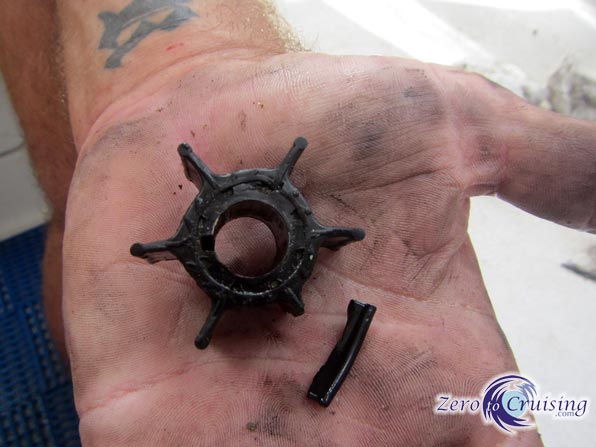Some repair jobs work out better than others
Either we’re getting better at this repair thing or Lady Luck was looking out for us yesterday but the service work that took over three days to complete on our starboard engine, we were able to complete in only four hours on our port side engine. To tell the truth, I know if was both a bit of luck and practice that allowed the job to go so quickly.
We now have the engine removal drill down pat and even though it took over 45 minutes to get set up and get the engine out of the well, we didn’t have to stop and wonder about what to do. As you can see from the pic below, we ended up doing this service work just in the nick of time. One piece of the impeller had broken off but it was easily retrieved from the water pump housing. We replaced it, the gear oil, engine oil and spark plugs. We checked and cleaned the oil filter and also cleaned and lubricated the rest of the engine.

In addition to all of the above, we also replaced the zinc on the engine. Following some advice from Cruising World, we even painted some nail polish around the bolts which hold the zinc in the hope that it might increase its lifespan. It probably wasn’t necessary as our zincs don’t seem to wear in that area but we figured that it couldn’t hurt.


Yesterday, someone asked me on Facebook what courses we have taken or what books we consult to do these types of repairs. The only repair course that I ever took was with the Power Squadron when we were back in Kingston and I found it to be a complete waste of time and money. We have two books that we consult for engine repairs: the official Yamaha service manual ($$$) and a Seloc service manual that we picked up in West Marine. Any answers not found in those two volumes are sourced from friends or from The Oracle.
In the category of things that did not go quite as well as we had hoped, our dinghy is still losing air. 🙁 I find this a bit disheartening as I really thought that we did a good job on that repair. Oh well, I guess we now have the opportunity to get a bit more practice on patching inflatables!


good job
Merci. (we’re practicing French).
Nice work!
I feel for you on the dinghy repair. I’m still battling leaks!
Eric
Just going to go take another look at it now.
Good job on the engine.
Are you sure it is not a new/different hole in the dinghy?
Mike
Possible but I think it’s unlikely. The leak (that we patched) is caused by chafe from the painter. It’s pretty obvious where it was occurring.
I always say Mike, that’s why on Cat we have two off everything. One to learn, one to remember forever.
Once done twice you are a pro, another advantage.
An important advantage!
Are your motors always in the water? I thought I saw a feature that allows Cats with outboards to retract them for less drag when sailing.
Do you ever rinse them with freshwater?
Yes, our engines can be raised. They are out of the water almost all of the time that they are not in use. No, we do not rinse them with fresh water. That is a luxury reserved for those people with access to tap water.
I see that Rebecca is giving the zinc a nice manicure 🙂
It goes on the lower unit so it must be a pedicure.
That nail polish may just stop that anode from working.
I doubt it. That is not the only spot making contact.
I’ve found the valves can leak very slowly, once they start to dry-out. You can replace them, or you can try lubing the gasket and insides by dribbling a little glycerine. Either lasts for 2-6 months. Don’t use oil; they won’t like it.
http://sail-delmarva.blogspot.com/2011/01/tip-for-day-gycerin-to-seal-tender-air.html
Where does one buy glycerine?
And I found where it was leaking, the same spot. I removed the patches and have taken a second attempt at the job.
Drug store.
Or try K-Y, though glycerine last longer.
Got it. Thanks.
Ahhh, what would we do without The Oracle!! I just brewed a 10 gallon, all-grain batch of beer with a little assistance from the very same Delphi resident…
Sounds awesome.